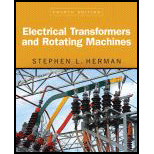
Electrical Transformers and Rotating Machines
4th Edition
ISBN: 9781305494817
Author: Stephen L. Herman
Publisher: Cengage Learning
expand_more
expand_more
format_list_bulleted
Concept explainers
Textbook Question
Chapter 2, Problem 7RQ
Each time constant of an exponential curve is equal to what percentage of the whole?
Expert Solution & Answer
Want to see the full answer?
Check out a sample textbook solution
Students have asked these similar questions
Which of these statements are correct?
*Hi, please help me with this differential equations questions and please show the full solution. Thank you very much. *
Question 1.) A load weighing 2 kg is attached to a spring. If the damping force is 5.5, spring constant is 4.2, and external force is sin(t), and the load is released from rest 0.2 inches below its equilibrium, determine the displacement of the object at any time t.
I need a clear step by step answer please :)
Chapter 2 Solutions
Electrical Transformers and Rotating Machines
Ch. 2 - What determines the polarity of magnetism when...Ch. 2 - What determines the strength of the magnetic field...Ch. 2 - Prob. 3RQCh. 2 - How many lines of magnetic flux must be cut in 1 s...Ch. 2 - Prob. 5RQCh. 2 - Into how many time constants is an exponential...Ch. 2 - Each time constant of an exponential curve is...Ch. 2 - An inductor has an inductance of 0.025 H and a...Ch. 2 - Prob. 9RQCh. 2 - What electronic component is often used to prevent...
Knowledge Booster
Learn more about
Need a deep-dive on the concept behind this application? Look no further. Learn more about this topic, mechanical-engineering and related others by exploring similar questions and additional content below.Similar questions
- Into how many time constants is an exponential curve divided?arrow_forwardWhy random errors is unavoidablearrow_forwardIn a linear spring finite element model, as per the finite element model’s sign convention, which one of the following statements is true? Select one: a. If Fe1 is positive then the spring is under tension b. If Fe2 is negative then the spring is under tension c. If Fe2 is positive then the spring is under compression d. If Fe1 is positive then the spring is under compression Clear my choicearrow_forward
- Thanks for your work. Can you please repost with pictures or any other way because my computer doesn't display all the solution steps (error showing equation)arrow_forwardWhat is "constitutive modeling". What are the 2 key parameters present in a constitutive model?arrow_forwardHEAT TRANSFER CASE: I want to know what temperature in (°F) the cylinder will have inside. It's a heat transfer problem. what is T2 ? HEAT TRANSFER They gave me an answer all squashed together that i can't make sense of it. If you could help me makes sense of it thank you!arrow_forward
- J 5arrow_forward1. Suppose identical solid spheres are distributed through space in such a way that their centers are lie on the points of a lattice, and spheres on neighboring points just touch without overlapping. (Such an arrangement of spheres is called a close-packing arrangement.) Assuming that the spheres have unit density, show that the density of a set of close-packed spheres on each of the four structures (the "packing fraction") is: fcc: bcc: √√2/6=0.74 √√3/8=0.68 SC: π/6=0.52 √√3/16=0.34 diamond:arrow_forwardI1 Give an example how it is applied in molecular dynamics simulation and Monte carlo simulation? Typical distributions of particles in a volume (e.g. crystal structure for a solid, or distribution of masses and velocities in a “typical” galaxy) - Distributions of particle velocities/energies (e.g. Boltzmann distribution at a fixed temperature) - E.g. for a liquid it is common to start with a solid crystal structure and let the structure “melt” (by setting appropriate velocities corresponding to the liquid phase temperature!) - E.g. to setup a collision of two galaxies, you could try to generate a stable distribution of masses and velocities for a single galaxy first by performing a separate simulation -E.g. A simple model of a phase transition between a low temperature ordered phase (ferromagnet) and high temperature disordered phase (paramagnet) whats the difference in phase space in Molecular dynamics and Monte Carlo simulation?arrow_forward
- PLEASE ANSWER QUICKLY WITH 30 MINUTES AND PLEASE FOLLOW THE INSTRUCTION. THANKSarrow_forwardEngineering Analyticsarrow_forwardIn a linear spring finite element model, as per the finite element model’s sign convention, which one of the following statements is true? Select one: a. If Fe1 is negative then the spring is under compression b. If Fe2 is negative then the spring is under tension c. If Fe1 is positive then the spring is under tension d. If Fe2 is positive then the spring is under tensionarrow_forward
arrow_back_ios
SEE MORE QUESTIONS
arrow_forward_ios
Recommended textbooks for you
 Electrical Transformers and Rotating MachinesMechanical EngineeringISBN:9781305494817Author:Stephen L. HermanPublisher:Cengage Learning
Electrical Transformers and Rotating MachinesMechanical EngineeringISBN:9781305494817Author:Stephen L. HermanPublisher:Cengage Learning Principles of Heat Transfer (Activate Learning wi...Mechanical EngineeringISBN:9781305387102Author:Kreith, Frank; Manglik, Raj M.Publisher:Cengage Learning
Principles of Heat Transfer (Activate Learning wi...Mechanical EngineeringISBN:9781305387102Author:Kreith, Frank; Manglik, Raj M.Publisher:Cengage Learning

Electrical Transformers and Rotating Machines
Mechanical Engineering
ISBN:9781305494817
Author:Stephen L. Herman
Publisher:Cengage Learning

Principles of Heat Transfer (Activate Learning wi...
Mechanical Engineering
ISBN:9781305387102
Author:Kreith, Frank; Manglik, Raj M.
Publisher:Cengage Learning
Physics - Thermodynamics: (21 of 22) Change Of State: Process Summary; Author: Michel van Biezen;https://www.youtube.com/watch?v=AzmXVvxXN70;License: Standard Youtube License